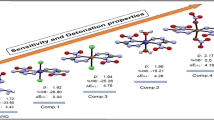Abstract
Accurate prediction of detonation pressure and velocity of an energetic compound through computer codes and empirical methods requires reliable value of its crystal density. This paper introduces a reliable method to estimate crystal density of a wide range of different types of energetic compounds. This method can applied for any energetic compounds containing at least –NO2, –NNO2, –ONO2, and furazan ring. It is based on some specific molecular fragments of energetic compounds. For 172 different energetic compounds, the root mean squares (rms) percent errors of the new correlation and one of the best available new group additivity methods are 2.16 and 11.0, respectively. The present method also provides more reliable predictions for new explosives such as N,N′-bis(1,2,4-triazol-3-yl)-4,4′-diamino-2,2′,3,3′,5,5′,6,6′-octanitroazobenzene and 2,4,6-tris(3′,5′-diamino-2′,4′,6′-trinitrophenylamino)-1,3,5-triazine.

Similar content being viewed by others
References
Mader CL (2007) Numerical modeling of explosives and propellants, 3rd edn. CRC Press, Boca Raton
Sikder AK, Maddala G, Agrawal JP, Singh H (2001) J Hazard Mater A 84:1–26
Agrawal JP (2010) High energy materials: Propellants, Explosives and Pyrotechnics. WILEY-VCH Verlag GmbH & Co, KGaA, Weinheim
Muthurajan H, Sivabalan R, Pon Saravanan N, Talawar MB (2009) J Hazard Mater 161:714–717
Keshavarz MH (2011) J Hazard Mater 190:330–344
Mosaei Oskoei Y, Keshavarz MH (2012) Fluid Phase Equilibr 36:1–14
Keshavarz MH (2012) Propellants Explos Pyrotech 37:489–497
Ghule VD, Srinivas D, Radhakrishnan S, Jadhav PM, Tewari SP (2012) Struct Chem 23:749–754
Nithya R, Sowmiya M, Kolandaivel P, Senthilkumar K (2014) Struct Chem 25:715–731
Rocha IM, Galvão TLP, Ribeiro da Silva MDMC, Ribeiro da Silva MAV (2013) Struct Chem 24:1935–1944
Fried LE, Howard WM, Souers PC (1998) CHEETAH 2.0 user’s manual. Lawrence Livermore National Laboratory, Livermore
Keshavarz MH (2011) In: Janssen TJ (ed) Explosive materials: classification, composition and properties. Nova Science Publishers, Inc., New York
Keshavarz MH (2011) In: Brar SK (ed) Hazardous materials: types, risks and control. Nova Science Publishers, Inc., New York
Keshavarz MH (2009) J Hazard Mater 165:579–588
Keshavarz MH, Pouretedal HR (2009) J Hazard Mater 169:158–169
Rice BM, Sorescu DC (2004) J Phys Chem B 108:17730–17739
Qiu L, Xiao H, Gong X, Ju X, Zhu W (2007) J Hazard Mater 141:280–288
Rice BM, Hare JJ, Byrd EFC (2007) J Phys Chem A 111:10874–10879
Kim CK, Cho SG, Kim CK, Park H, Zhang H, Lee HW (2008) J Comput Chem 29:1818–1824
Politzer P, Martinez J, Murray JS, Concha MC, Toro-Labbe´ A (2009) Mol Phys 107:2095–2101
Willer RL (2009) J Mex Chem Soc 53:108–119
Ammon HL (2008) Propellants Explos Pyrotech 33:92–102
Keshavarz MH (2007) J Hazard Mater 143:437–442
Keshavarz MH (2007) J Hazard Mater 145:263–269
Palmiii WJ (2005) Introduction to Matlab for engineers. McGraw-Hill, New York
Keshavarz MH, Esmail-poor K, Kavosh Tehrani K (2010) Propellants Explos Pyrotech 35:482–486
Tarver CM (1979) J Chem Eng Data 24:136–145
Meyer R, Köhler J, Homburg A (2002) Explosives, 5th edn. Wiley-VCH, Weinheim
Pagoria PF, Lee JS, Mitchell AR, Schmidt RD (2002) Thermochim Acta 384:187–204
Sikder AK, Sikder N (2004) J Hazard Mater A 112:1–15
Agrawal JP, Hudgson RD (2007) Organic chemistry of explosives. Wiley Ltd, West Sussen
Agrawal JP (1998) Prog Energy Combust Sci 24:1–30
Acknowledgments
We would like to thank the research committee of Malek-ashtar University of Technology (MUT) for supporting this work.
Author information
Authors and Affiliations
Corresponding author
Rights and permissions
About this article
Cite this article
Keshavarz, M.H., Soury, H., Motamedoshariati, H. et al. Improved method for prediction of density of energetic compounds using their molecular structure. Struct Chem 26, 455–466 (2015). https://doi.org/10.1007/s11224-014-0502-7
Received:
Accepted:
Published:
Issue Date:
DOI: https://doi.org/10.1007/s11224-014-0502-7




